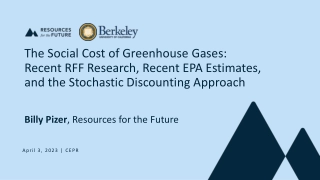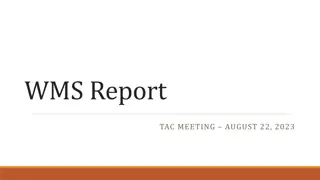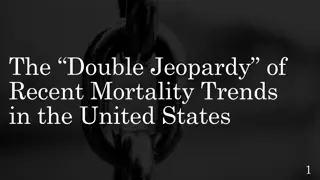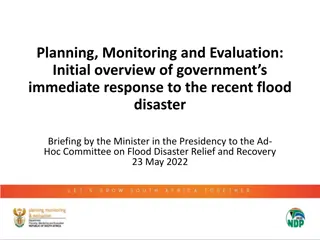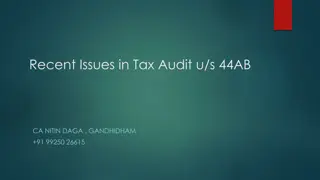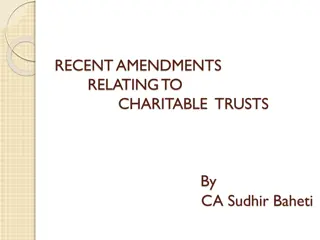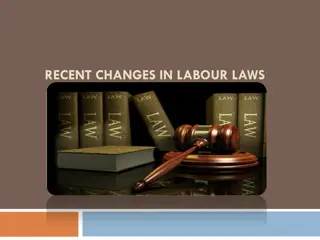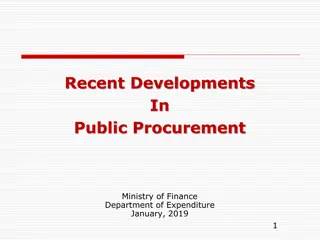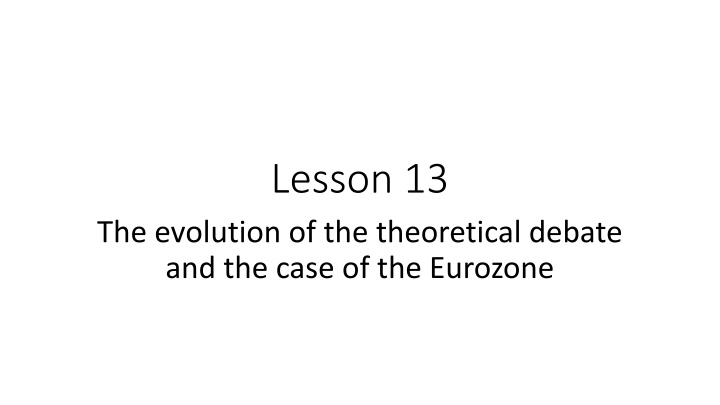
Evolution of Theoretical Debate and the Eurozone Case
Explore the evolution of theoretical debates in economics, focusing on Real Business Cycle Theory (RBC), New Keynesian Economics (NKE), and the New Neoclassical Synthesis (NNS). Understand the assumptions, implications, and impacts of these economic theories, especially in relation to fiscal and monetary policies in the Eurozone context.
Download Presentation

Please find below an Image/Link to download the presentation.
The content on the website is provided AS IS for your information and personal use only. It may not be sold, licensed, or shared on other websites without obtaining consent from the author. If you encounter any issues during the download, it is possible that the publisher has removed the file from their server.
You are allowed to download the files provided on this website for personal or commercial use, subject to the condition that they are used lawfully. All files are the property of their respective owners.
The content on the website is provided AS IS for your information and personal use only. It may not be sold, licensed, or shared on other websites without obtaining consent from the author.
E N D
Presentation Transcript
Lesson 13 The evolution of the theoretical debate and the case of the Eurozone
Real business cycle theory (RBC) Assumptions dynamic general equilibrium perspective perfect competition According to RBC theory prices clear the market, rational expectations allow consumption and expenditure to be smoothed across time and it is not necessary to intervene with fiscal policy to increase output and employment since they stand along their long-run value
New Keynesian Ecoonomics (NKE) Assumptions partial equilibria nominal rigidities imperfect competition According to new-Keynesian economics the presence of monopoly power, wage and prices rigidities, and liquidity constraints and accommodative monetary conditions on interest and exchange rates allow short-run fluctuations caused by discretionary fiscal policy measures to be explained. it is worth mentioning the so-called non- Keynesian effects of Keynesian fiscal policy - then extended to Keynesian effects of non-Keynesian fiscal policy
New neoclassical synthesis (NNS) The new-classical economics and the new-Keynesian economics combined into a new paradigm known as the New Neoclassical Synthesis rational expectations and intertemporal optimization with imperfect competition and wages and prices rigidities in the short run. It has become, in the last 20 years the leading paradigm thanks to a set of analytical instruments summarised in the Dynamic Stochastic General Equilibrium (DSGE) models first presented by Rotemberg and Woodford (1997).
NNS evolutions Before the crisis it contributed to the removal of fiscal intervention from the set of macroeconomic policy instruments and to the ever greater importance assigned to the monetary policy interest rate setting strategy to reduce output fluctuation along its long-run value. According to neoclassical economics money is neutral in the long run and real and monetary equilibria are independent of each other. After the crisis Despite the at times excessively abstract assumptions contained in these models (Goodhart and et al. 2009 among many others), the greatest merit is to have underlined that the effects of fiscal policy cannot be evaluated separately from the monetary conditions (interest rates or exchange rates). However, since the structure of the model built with micro-foundations - allows changes in exogenous variables to be taken into account contemporaneously, after the crisis the NNS s economists opened themselves (Woodford 2011) to far-reaching revisions, including an active role of government interventions.
Competing schools of thought and fiscal policy: hypotheses and outcomes Schools of thought Hypotheses Outcomes Theory of Consumption Nature of Expectations Prices/ wages long run around output potential long run below output potential Additional hypothesis short run how it is financed, presence of the crowding-out effect, degree of openness Keynesian economics Current income Adaptive Constant positive positive positive liquidity constraint, life horizons, wealth effects, closed economies, fixed exchange rate, monetary policy rule New Keynesian Economics Imperfect information/ bounded rationality negative, positive or null Permanent income sticky null positive no wealth effect, sustainability of public accounts Neoclassical Economics Intertemporal optimization Rational Flexible negative or null null null or negative New neoclassical Synthesis Intertemporal optimization under different policy rules negative positive or null Intertemporal optimization Rational Sticky null positive
The case of the Eurozone The policy framework in the Eurozone was the most faithful implementation of the fiscal policy ineffectiveness theoretical principles: because public expenditure is unable to change the long-run equilibrium income, it is better to avoid the real financial instability deriving from the excessive issue of public debt. Fiscal discipline is a necessary prerequisite for long-run stable growth. National governments belonging to the EMU are supposed to respect rigid parameters and cannot use fiscal policy freely. Sustainable public finance was considered a precondition for higher investor confidence, for greater consumption and investment and, therefore, for long-run stable growth. Special attention was given to the need to reduce the amount of outstanding government debt because of its long-run macroeconomic impact and the consequent inability to deal with increasingly ageing populations and rising social insurance costs. Government debt has a non-linear relationship with GDP and when it exceeds a certain threshold, it is associated with decreasing growth
Why fiscal rules? It is an instrument of external discipline, substituting or complementing domestic discipline. There are a number of externalities specifically linked to the presence of a common currency: the incentive to run deficits with a fixed-exchange rate; the existence of a financial cost of debt default due to bank holdings of government debt; the presence of economic costs of a debt default due to the risk of pressure on the ECB to inflate away.
The revision after the crisis The crisis has the great merit of having brought back into the theoretical and practical debate the role of fiscal policy in defining macroeconomic equilibrium. Since 2007 most advanced economies have experienced a general decline in macroeconomic conditions which the central banks alone have been unable to counteract. Monetary policy authorities worldwide have been facing the existence of a (real) zero lower bound on the interest rate; in particular the European Central Bank, despite setting negative nominal interest rates, has been unable to inflate money into the economy and reach the target inflation of 2%. Aggregate demand is not growing, and despite the great support to public accounts of decreasing refinancing costs, fiscal policy in the Eurozone has for those countries needing it no room for action- However, despite these findings, the Eurozone appears - using a political economy perspective - to be at a stalemate in which the interests of some countries, which would most benefit from the respect of rules, appear to prevail over those of the whole currency union.
Fiscal policy is effective when Ricardian equivalence does not hold 1. the fiscal stimulus is directed to liquidity-constrained consumers, who cannot otherwise spend their expected future higher income; 2. if consumers do not take fully into account the future tax increase as a consequence of a greater deficit (expectations are not rational or information is not perfect).
Fiscal policy is effective whenmonetary conditions are accommodative. 3.1 the nominal interest rate does not increase in response to fiscal expansion, such that there is no crowding-out effect on domestic investment and consumption. 3.2 the exchange rate is fixed or there is a common currency. Under fixed exchange rates the pressure on aggregate demand exerted by fiscal expansion is automatically translated into accumulation of foreign reserves and therefore into an increase in aggregate money supply. It is thus equivalent, other things being equal, to financing public spending. Under the common currency the settlements mechanism working though the balance of payment equilibrium is managed by the TARGET system , resulting in a similar adjustment mechanism
Fiscal policy is effective when The current output is far below its potential level and resources are underutilized When output is far below its potential level the supply curve is horizontal, such that an increase in aggregate demand does not raise prices. These circumstances reproduce the old Keynesian conditions according to which an increase in autonomous demand causes other things being equal - a more then proportional effect on aggregate equilibrium income
Fiscal policy is effective when It is able to modify the long-run rate of growth When public expenditure is allocated to increase output potential, it causes a contemporaneous increase in aggregate demand and supply, thereby generating an increase in the long-run rate of growth. This happens, for example, when public spending is allocated to investments, to creating favourable opportunities for fixed capital formation, to increasing human capital or to R&D and so on.

